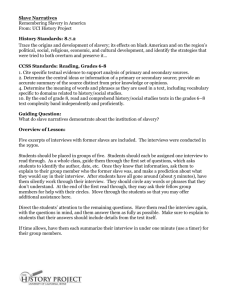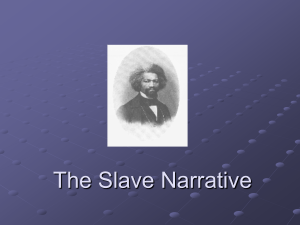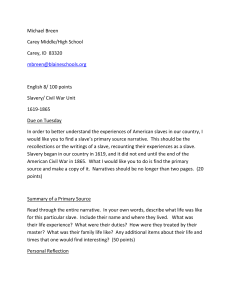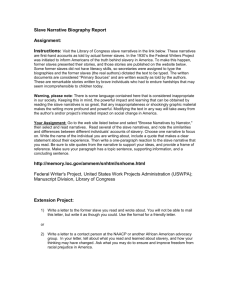lest we remember lest we forget
advertisement
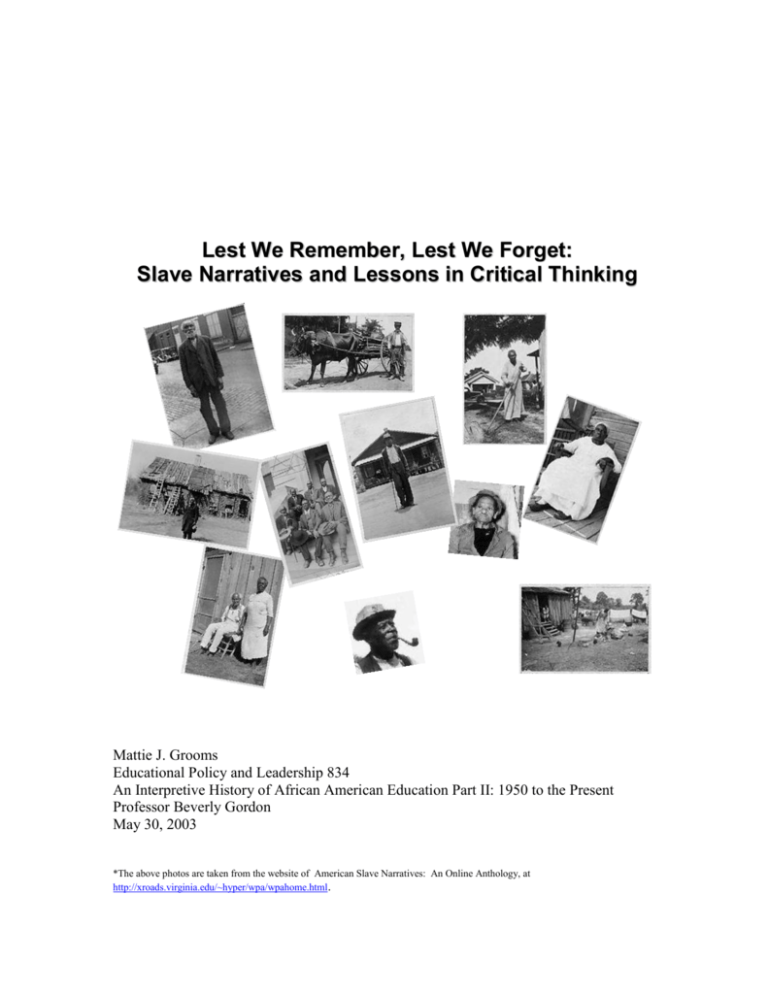
Lest We Remember, Lest We Forget: Slave Narratives and Lessons in Critical Thinking Mattie J. Grooms Educational Policy and Leadership 834 An Interpretive History of African American Education Part II: 1950 to the Present Professor Beverly Gordon May 30, 2003 *The above photos are taken from the website of American Slave Narratives: An Online Anthology, at http://xroads.virginia.edu/~hyper/wpa/wpahome.html. “I never see how my mammy stan’ sech ha’d work. She stan’ up fo’ her chillun tho’. De ol’ overseeah he hate my mammy, case she fight him for beatin’ her chillun. Why she git more whuppins for dat den anythin’ else. She hab twelve chillun. I member I see de three oldes’ stan’ in de snow up to dey knees to split rails, while de overseeah stan off an’ grin.” Fannie Moore, former slave “How could they make us slaves? They had to do the same thing to us that we do to a horse. When you take a horse out of the wilds, you don’t just jump on him and ride him, or put a bit in his mouth and use him to plow with. No you’ve got to break him in first….It takes a cruel man to break him in, a mean man, a heartless man, a man with no feelings….If you find the role that slave maker played, I’m telling you, you’ll find it hard to forget and forgive, you’ll find it hard.” Malcolm X 2 Overview In the 1930s, the Works Progress Administration dispatched writers all over America to interview the last remaining black witnesses to slavery. Long ignored by historians, the recordings and printed interviews gained the attention of scholars during the civil rights movement. Concerned with slavery not as one of several causes of the Civil War but, rather, as the primary experience of millions of Americans, this new generation of historians pored over the narratives as a means of gaining access to the slaves’ voices. The narratives, once dismissed as historical ephemera, had moved to the center of the study of slavery. Now these intuitive accounts—in recorded voice and in the printed word—of confrontations with owners, of long hours in the field, of maintaining families with the legitimating force of law, and of sustaining dignity in the most inhumane circumstances, are now available. “We were slaves,” said Fountain Hughes, “If I had an idea that I’d ever be a slave again, I’d take a gun and just end it all right away” (Berlin, p15). As historical documents, slave narratives chronicle the evolution of white supremacy in the South from eighteenth-century slavery through early twentieth-century segregation and disfranchisement. As autobiography, these narratives give voice to generations of black people who, despite being written off by white southern literature, still found a way to bequeath a literary legacy of enormous collective significance to the South and the United States (Andrews). In 1935, Franklin Delano Roosevelt’s administration embarked on the largest governmental intervention into cultural production in the history of the United States when it put forty thousand unemployed artists to work in four Federal Arts Projects 3 (visual arts, theater workers, musicians, and writers). Amid the contentious debates around government funding of the arts today, the New Deal experiments tend to get forgotten or brushed aside as unique to the economic and political conditions of the Depression. Yet, the Works Progress Administration (WPA) Arts Projects were on the cusp of the modern bureaucratization of culture, at the moment when the federal government exponentially extended its reach into people’s daily lives. The result of these efforts was the Slave Narrative Collection, a compilation of autobiographical accounts of former slaves. Compiled in seventeen states during the years of 1936-1938, the collection consists of more than two thousand interviews with former slaves, most of them first-person accounts of slave life and the respondents’ own reactions to bondage. The interviews afforded aged ex-slaves an opportunity to give their personal accounts of life under the “peculiar institution,” to describe in detail and in their own words what it felt like to be a slave in the United States (Yetman, p 23). Sarah Debro, once a slave in North Carolina, put it bluntly: “My folks don’t want me to talk about slavery. They’s shame niggers ever was slaves” (Hurmence, pvii). Many Americans, white and black, prefer to overlook Sarah’s role in that infamous period of United States history. After all, “we” are not the ones to blame for her enslavement. Why bring it up at this late date? Why talk about slavery? The answer is Sarah. To ignore her life under slavery is to ignore black pioneering in the United States—and, in effect, to deny Sarah’s humanity, as it was denied in slavery time. That is why Sarah must be allowed to speak for herself. That is why it is important for her to talk about slavery. It was important to talk to the WPA interviewers on the matters of food, clothing, housing facilities, working conditions, 4 amusements, religious practices, educational opportunities, family life, punishments, and any other information obtainable (Cade, p294). From the time the new republic came into being, Americans wrestled with the problem of Sarah. Her very existence mocked the validity of a government that guaranteed liberty and justice for the nation’s people. One argument solemnly maintained that Sarah was not a person, that she counted only as property; and the Bible was cited as proof that her master was entitled to dispose of his property as he saw fit. The argument prevailed, for economic reasons, and a system of government grew up around Sarah that provided for her liability under the law but provided her with no protection under that same law. She could not vote. She could not marry. She could not even claim as her own the children she bore, for they too were the property of her master. The system worked well enough that millions of slaves remained in bondage for almost three hundred years in America. It worked poorly enough that increasingly restrictive Slave Codes had to be written to keep the human property under control. Slaves were legally forbidden to read and write. Slaves could not buy and sell merchandise. They could not own or fire guns; they could not ride horses without permission. No gambling, no liquor, no preaching or holding religious services or other meetings, no slandering a free white person, no insolence to a free white person—and the list grew longer with each new Code (Hurmence, p17). Even so, the slaves persisted in behaving like human beings. The passions that drove their masters surged in these people of oppression: joy and sorrow, love and hatred, generosity and greed. They had dreams and hopes, and they were aware of their dreams 5 and hopes in the way that all people are aware. The Code that governed them never succeeded in eradicating their humanity. When Freedom came in 1865, hard times came too. Many former slaves lamented that their sufferings multiplied after the War Between the States. At least in the old days there had been certainty of food, clothing, and shelter. Now there was no certainty, and nobody would listen to their problems. It was true that nobody wanted to listen. Both the North and South, so recently divided, discovered common ground in righteous indignation: the slaves had been set free so why were they not properly appreciative? Their unseemly grievances tarnished America’s image. If they would not put their past behind them, they ought at least, for history’s sake, to keep quiet about it. The Federal Writer’s Project, created in those hard times to provide work for the jobless writers and researchers, initiated a program in which field workers were dispatched throughout the slave states to interview those who had experienced slavery, wherever they might be found. Vivid voices they were, who, at last, were having their say about that murky time “before Freedom.” Sylvia Cannon, former slave of “Old Marse Bill Briggs,” in Florence County, South Carolina: “At night the overseer would walk out to see could he catch any of us walking without a note, and to this day, I don’t want to go nowhere without a paper” (Regosin, p182). Fannie Griffin, once the slave of Joe Beard in Columbia, South Carolina: “I think about my old mammy heap of times now and how I’ve seen her whipped, with the blood dripping off of her” (Regosin). 6 Taken as they come, the folk histories of America’s former slaves ring true. The artlessness of the ex-slaves brings authenticity to their words. The same can almost be said of the interviewers, who had no formal schooling in the task given to them. They were supplied with a list of questions to ask, instructed to write down the answers as nearly verbatim as possible. These former slaves, most born in the last years of the slave regime or during the Civil War, provided first-hand accounts of their experiences on plantations, in cities, and on small farms. Their narratives are an unequaled resource for understanding the lives of America's four million slaves. What makes the WPA narratives so rich is that they capture the very voices of American slavery, revealing the texture of life as it was experienced and remembered. Each narrative taken alone offers a fragmentary, microcosmic representation of slave life. Read together, they offer a sweeping composite view of slavery in North America, allowing us to explore some of the most compelling themes of nineteenth-century slavery, including labor, resistance and flight, family life, relations with masters, and religious belief. The narratives of former slaves are one of the few resources that readers can examine to get a reliable, first-hand portrayal of what slavery had actually been like. 7 Student Lesson Plan Title: Unit on Critical Analysis of Slave Narratives Lesson Summary of Goals and Objectives: Students will examine and interpret slave interviews obtained by writers working for the WPA during the 1930s. A close study of the narratives will enable students to: o Understand the specific tasks undertaken by the writers employed by one of the relief programs of the New Deal. o Obtain a more personal sense of the past by examining the institution of slavery. o Obtain a more personal sense of the past by examining the lives of ex-slaves as told to the WPA interviewers. o Explore the diversity of human experience in order to analyze and interpret significant events, patterns and themes in the lives of the former slaves. o Learn about the process and issues involved in doing oral history. o Develop library and Internet skills about a particular time in history. o Locate general geographic features within the United States. o Recall demographic and historical facts about the North and South. o Use historical facts to support the different perspectives of the North and South (both pre- and post-Reconstruction). o Relate the stress factors of both slaves and former slaves to their own lives. o Critically analyze the Declaration of Independence and the Constitution of the United States. Estimated Time Duration: Ten 55-minute lessons Ohio Standards Connections: This unit can be utilized by both ELA and Social Studies content areas. Standard: ELA o Reading Applications: Informational, Technical and Persuasive Text Standard o Reading Applications: Literary Text Standard o Writing Process Standard o Writing Applications Standard o Writing Conventions Standard o Research Standard 8 o Communication: Oral and Visual Standard Social Studies o History o People in Societies o Geography o Economics o Government o Citizenship Rights and Responsibilities o Social Studies Skills and Methods Lesson 1: An Examination of Interviews from the American Slave Narratives Estimated class time: Three to four class periods. Description: This lesson is organized into three sections: 1. Students will read selected oral histories in order to learn about individual experiences of African Americans in the pre-Civil War period. 2. Students will meet in small groups with other students who read the same oral history and share their understandings and develop different perspectives on the reading. 3. Students will gather in small groups and share their understandings with students who read different narratives. Here the goal for students is to broaden their understanding of what the experience of slavery was like for individual African Americans. Lesson 2: Generating a Student-created Document Based Question Estimated class time: Six to eight class periods Description: This lesson requires students to work individually and in groups to accomplish particular discrete tasks. Teachers may wish to establish benchmarks or time frames in order to hold students accountable for particular short term objectives. 1. Students will work independently to gather four documentary sources that inform a focusing question about the experience of slavery. 2. Students will work collaboratively in groups of four or five and select approximately 10-12 of their collected documents for presentation in the form of a Document Based Question. 3. Collaborating groups will assemble their documents into a packet Collaborating groups will exchange and assess one another's Document Based Question. 4. Optional: Individual students may be instructed to write an essay in response to the DBQ created by one of the other groups 9 Lesson 3: Comparing and Contrasting the Individual Experiences of African Americans in the 19th Century Estimated class time: 2-3 class periods Description: This lesson provides a guided opportunity for students to interrogate the ExSlave Narratives for information about selected topics. 1. Students will be led in a discussion about the strengths and limitations of using the ex-slave narratives and other oral histories as primary sources in the study of history. 2. Students will be introduced to the hypertext index created by the New Deal Network and assigned a specific guiding question or task to investigate. 3. Students will compile data from their investigations and share their results. Differentiated Instructional Support for All Learners: Instruction differentiated according to learner needs, to help all learners either meet the intent of the specified indicator(s) or, if the indicator is already met, to advance beyond the specified indicator(s). Homework Options and Home Connections: o Interview a family member or neighbor who is older than 80 years old. Student should formulate interview questions based on discoveries about the New Deal programs and geographical residences during the interviewee’s lifetime. o Write a short story about an African American who was born in the 1850s. o Analyze any newspaper articles related to immigration—legal and illegal. Materials and Resources Needed: Students will work with the slave narratives collected by the New Deal Network as well as additional sources. Teachers may wish to preview and download one or more of the narratives found in the collections listed on the resource page. Students may have to be lead through the selected interview and prepared for the nature of the stories they will be reading and the language which they might encounter. Writing Prompt: How might your life be different today if African American’s were still in bondage? 10 11 12 13 *This narrative is taken from Born in Slavery: Slave Narratives from the Federal Writers' Project, 1936-1938 Ohio Narratives, Volume XII. 14 Selected Readings on American Slavery and Slave Narratives Anderson, S.E.; The Black Holocaust for Beginners; New York: Writers and Readers Publishing, Inc.; 1995. Bayliss, John F.; Black Slave Narratives: Life Under Slavery as Told By Its Victims in America; New York: MacMillan Company; 1970. Berlin, I., Favreau, M., and Miller, S. F. (eds.); Remembering Slavery: African Americans Talk About Their Personal Experiences of Slavery and Emancipation; 1998; New York: New Press. Blassingame, John W. ed., Slave Testimony: Two Centuries of Letters, Speeches, Interviews, and Autobiographies. Baton Rouge: Louisiana State University Press, 1977. Bold, Christine; The WPA Guides: Mapping America; Jackson, Mississippi: University Press of Mississippi; 1999. Botkin, B.A.; Lay My Burden Down: A Folk History of Slavery; New York : Delta, 1994. Cade, John B. “Out of the Mouths of Ex-Slaves,” in The Journal of Negro History, Volume 20, Issue 3 (July, 1935), pp.294-337. Constitution of the United States. Epps, Archie; Malcolm X: Speeches at Harvard. New York: First Paragon House; 1991. Escott, Paul D. Slavery Remembered: A Record of Twentieth-Century Slave Narratives. Chapel Hill: University of North Carolina Press, 1979. Gates, Henry Louis, Jr.; Unchained Memories: Readings from the Slave Narratives; Boston: Bulfinch Press; 2002. Genovese, Eugene D., Roll, Jordan, Roll: The World the Slaves Made. New York: Pantheon, 1974. Govenar, Alan; African American Frontiers: Slave Narratives and Oral Histories; Santa Barbara, CA.: ABC-CLIO; 2000. Howard E., ed. A Comprehensive Name Index for the American Slave. Westport, Conn.: Greenwood Press, 1997. Hurmence, Belinda; Before Freedom: 48 Oral Histories of Former North and South Carolina Slaves. New York: Penguin Books; 1990. Isserman, Maurice; Journey to Freedom: The African-American Great Migration; New York: Facts on File, Inc.; 1997. McLaurin, Melton. Celia: A Slave. Athens: University of Georgia Press, 1991; rpt. ed., New York: Avon Books, 1993. Mjagki, Nina; The Human Tradition: Portraits of African American Life Since 1865; Wilmington, DE.: Scholarly Resources, Inc.; 2003. 15 National Archives and Records Administration; The Emancipation Proclamation; Washington, D.C.: Library of Congress; 1993. Perdue, Charles L. Jr., Thomas E. Barden, and Robert K. Phillips, eds., Weevils in the Wheat: Interviews with Virginia Ex-Slaves. Charlottesville: University Press of Virginia, 1976. Rapport, Leonard. "How Valid Are the Federal Writers' Project Life Stories: An Iconoclast Among True Believers," Oral History Review (1979): 6-17. Regosin, Elizabeth. Freedom’s Promise: Ex-Slave Families and Citizenship in the Age of Emancipation. Charlottesville: University Press of Virginia; 2002. Smithsonian Institution Press; Captive Passage: The Transatlantic Slave Trade and the Making of the Americas; Washington, D.C.: Smithsonian Institution; 2002. Sterling, Dorothy (ed.); The Trouble They Seen: Black People Tell the Story of Reconstruction; Garden City, N.Y.: Doubleday; 1976. Wright, Richard; 12 Million Black Voices; New York: Thunder’s Mouth Press; 1988. Web Sites African American Mosaic at, http://lcweb.loc.gov/exhibits/african/afam015.html. African American Odyssey at http://memory.loc.gov/ammem/aaohtml/aohome.html. American Slave Narratives: An Online Anthology at, http://xroads.virginia.edu/~hyper/wpa/wpahome.html. Been Here So Long: Selections from the WPA American Slave Narratives at, http://newdeal.feri.org/asn/index.htm Born in Slavery: Slave Narratives from the Federal Writers’ Project, 1936-1938 at, http://memory.loc.gov/ammem/snhtml/snhome.html. Excerpts from Slave Narratives; Edited by Steven Mintz, at, http://vi.uh.edu/pages/mintz/primary.htm. Library of Congress. Born in Slavery: Slave Narratives from the Federal Writers' Project, 1936-1938 Ohio Narratives, Volume XII. http://memory.loc.gov/cgibin/ampage?collId=mesn&fileName=120/mesn120.db&recNu m=17&itemLink=D%3Fmesnbib%3A1%3A.%2Ftemp%2F%7Eammem_Er9b%3A%3A RaceMatters.org Smithsonian Productions Presents Remembering Slavery at http://rememberingslavery.org/. 16 Third Person, First Person: Slave Voices from the Special Collections Library at, http://scriptorium.lib.duke.edu/slavery/. University of North Carolina at Chapel Hill Libraries: Documenting the American South; North American Slave Narratives at, http://docsouth.unc.edu/neh/neh.html. (All web sites were accessed during the week of May 25, 2003) Audio and Video Resources Africans in America: America’s Journey Through Slavery, 4-volume video set from WGBH; 1998. Freedman’s Bank Records CD-ROM by FamilySearch; 2002. Smithsonian Productions Presents Remembering Slavery: Live Recordings and Dramatic Readings of Interviews with Former Slaves; 1999. The Middle Passage DVD from HBO; 2003. Unchained Memories DVD from HBO; 2002 (All audio and video resources are available through the Columbus and Franklin County Public Library) 17

